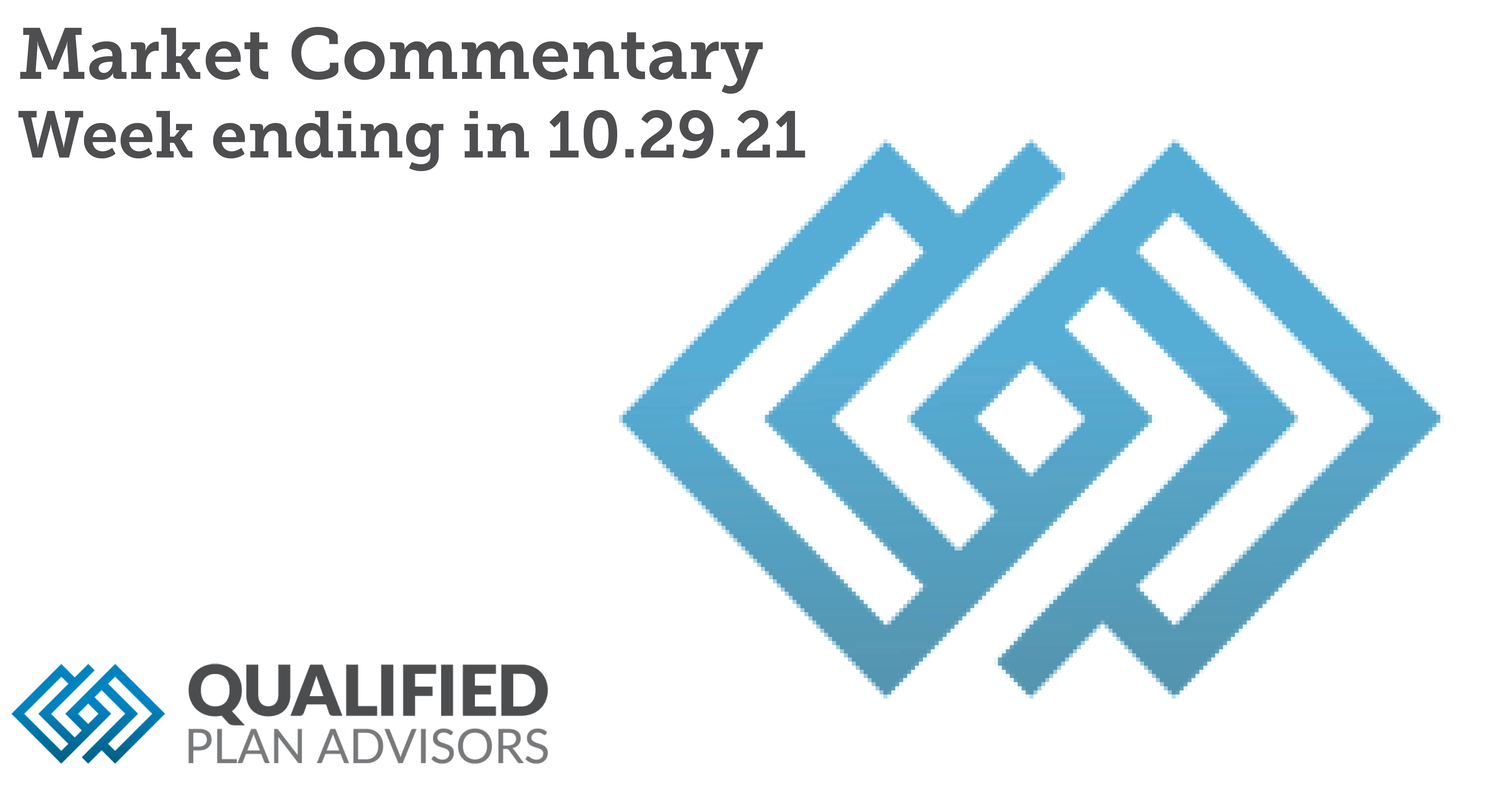The experts from Prime Capital Investment Advisors and Qualified Plan Advisors came together to present their quarterly webinar intended to help retirement plan participants and individual investors make sense of the market and economic news.
Prime Capital Investment Advisors Hires Scott Duba as Chief Investment Officer and Managing Director, Wealth Management
Prime Capital Investment Advisors (PCIA) announces the hiring of Scott Duba, CFA as its Chief Investment Officer and Managing Director, Wealth Management.
Charting a Safe Course Through Retirement
Retirement should be a time to enjoy the fruits of decades of working and saving, right? Part of enjoying the retirement years is having the peace of mind that comes from understanding some aspects of retirement that many people don’t consider.
Week-in-Review: Week ending in 11.05.21
U.S. Equities took flight after a stronger than expected jobs report on Friday. The S&P 500 has closed at new highs for seven days in a row.
Week-in-Review: Week ending in 10.29.21
U.S. Equities shrugged off a miss on GDP and mega cap tech earnings disappointments and the S&P 500 and Nasdaq set fresh highs.
Qualified Plan Advisors Creates New Position Responsible for Advisor Managed Accounts
Qualified Plan Advisors (QPA) is pleased to announce the hiring of Kevin Toledano as their first-ever Director of Managed Account Services. Toledano comes to the company with decades of industry experience, most recently having spent 15 years running the in-plan managed account program at AIG Retirement Services.
Qualified Plan Advisors: June Advocate Newsletter
Lessons from 401(k) Litigation During the Pandemic
In many ways, the world came to a halt when the COVID-19 pandemic hit. Retirement plan sponsors and fiduciaries should be aware that this certainly was not the case for plaintiffs’ firms. In the context of retirement plan litigation, in fact, they only picked up the pace.
After we saw roughly 50 class action retirement fee lawsuits filed in each of 2016, 2017, and 2018, that number fell off dramatically to around 20 in 2019. One might have expected that fall-off to continue during the pandemic. To the contrary, though, we saw nearly 100 suits filed in 2020 alone.
As always, we don’t consider fear to be the primary reason to pay attention to retirement plan fee litigation. Those plaintiffs’ complaints present opportunities for other plan sponsors and fiduciaries to understand trends and evolving expectations for reasonableness. Without regard to the ultimate outcome of the many (many) lawsuits initiated over the last several months, we can learn a lot of lessons by digging into the trends and allegations. During tomorrow’s Fiduciary 15 webinar, we’ll dive deeper into lawsuits fitting into three broad categories.
Revenue Sharing Is Still an Issue. It is a bit surprising to see that many plan sponsors – particularly those sponsoring larger plans – continue to rely on expensive investment options to generate revenue sharing that offsets plan expenses. Here is the basic pattern of allegations in those lawsuits:
1. Plan committee used more expensive versions of investment options when a cheaper version was available.
2. This resulted in excessive gross investment expenses.
3. Plan committee members have a fiduciary responsibility to seek cheaper versions (i.e., share class, CIT, and/or separate account) of any investment option made available.
4. They failed to meet that responsibility because they wanted to generate revenue sharing.
5. But they also failed to meet the responsibility to benchmark the recordkeeping expenses.
6. If they had benchmarked the recordkeeping expenses, they’d have discovered that the revenue sharing approach resulted in excessive recordkeeper fees.
7. Thus, even though a portion of the allegedly excessive investment fees were used to offset recordkeeping expenses, the total cost of the plan was unreasonable.
What do we learn from this? Committees should ensure that the plan is indeed using the cheapest or most efficient version of the investment options made available to participants. They also should be aware of the fee arrangement for the recordkeeper and monitor the total fees the recordkeeper receives.
There’s a Growing Target on Target Date Funds. The plaintiffs’ firms have really honed in on target date funds (TDFs). From a pure numbers perspective, this makes a lot of sense. With increasing frequency, plans have been using automatic enrollment and selecting TDFs as the plan’s default investment option. This means that a larger portion of plan assets are invested in TDFs, which in turn presents a more appealing prize for plaintiffs’ firms.
When plan fiduciaries establish TDFs as the default investment, they frequently rely on the Department of Labor’s safe harbor for a “Qualified Default Investment Alternative” or QDIA. That safe harbor treatment can provide a false sense of security, though, because plan fiduciaries end up paying less attention to the TDFs than to a plan’s core funds menu. The accelerating string of TDF lawsuits attack various aspects of plan’s TDFs:
* Expensive share class (with a cheaper share class or CIT version available)
* Proprietary fund usage (without supporting due diligence)
* Poor performance
* Using more expensive active TDFs instead of cheaper passive TDFs
What do we learn from this? Prudent fiduciaries will give more attention to their plan’s TDFs. It is time to ramp up the committee’s understanding of a plan’s particular TDFs, why they were chosen, and whether they remain the most reasonable option for the plan’s participants. If you’re a QPA client, please ask about our firm’s new “Target Date Deep Dive” capabilities, which will help you to take a closer look at your TDFs and to complete a checklist reflecting the DOL’s expectations.
Data Is at Greater Risk Than Ever Before. This probably doesn’t surprise anyone. We live through electronic data. Our retirement plan data is accessed electronically on a frequent basis and data is more frequently moving in electronic form with more remote workers.
The recent lawsuits target a couple of distinct data-related risks: (1) identity and account theft; and (2) recordkeepers using plan data to cross-sell. The DOL has provided a package of tips and best practices intended to help with the cybersecurity risks. That package will help plan fiduciaries and participants to manage those risks. Federal courts have not provided the same help with respect to cross-selling, however, as they’ve generally supported recordkeepers’ ability to use plan data for a variety of business purposes. This means that plan fiduciaries will have to become more diligent.
Closing Thoughts. There is a lot happening on the litigation front – far more than we can address in one short monthly newsletter. Our Fiduciary 15 webinar will provide you with more examples and best practices. Please take 15 minutes to join us and don’t hesitate to reach out if you have any additional questions.
Week-in-Review: Week ending in 06.18.21
The Bottom Line
- Equities finished another volatile week solidly lower, with the S&P 500 dropping ‐1.9%. After leading large caps for three consecutive weeks, the small cap Russell 2000 fell sharply, losing ‐4.2% for the week.
- The yield on the 10‐year U.S. Treasury was little changed, down‐1 basis point, but that masked some big swings in the bond market. Following a surprisingly hawkish tone by the Fed, short yields doubled and long yields fell.
- Homebuilder confidence remains historically high, but it has been dropping lately and now building permits are falling too. Meanwhile May retail sales were softer than expected and unemployment claims unexpectedly rose.
Stocks battered, yield curve flatter
Global equities finished another volatile week solidly lower, as the U.S. Federal Reserve surprised markets by forecasting earlier‐than‐expected rate hikes and indicated it will discuss tapering asset purchases in coming meetings. The Federal Open Market Committee (FOMC) is now forecasting that it will hike rates twice in 2023 after previously predicting no hikes until 2024. Comments from St. Louis Fed President James Bullard—a non‐voting member this year—added to the Fed’s hawkish tenor with his comments Friday morning. The so called “reflation trade”, which favored value stocks and commodities, came under immediate pressure following the FOMC shift. The bond market also saw significant swings this week as the Treasury yield curve flattened noticeably, with the yield on the 2‐year note almost doubling and longer‐term yields, such as the 30‐year bond, falling (the 30‐ year US Treasury yield plunged ‐16 basis points on Thursday alone). The U.S. Dollar Index rallied to levels not seen since April. Economic data didn’t help as May retail sales came in softer than expected, manufacturing growth in New York and Philadelphia slowed, jobless claims snapped a string of weekly declines, and producer inflation ran hot.
Digits & Did You Knows
SLIGHTLY USED — The average age of vehicles on U.S. roads last year was 12.1 years, a record high. The average has been rising steadily for 15 years as car quality has improved, but the pandemic accelerated the trend (source: Dow Jones).
LEAVING TOWN — Between 7/01/19 and 6/30/20, 5 of the 10 largest cities in the U.S. saw their populations decline – New York City, Los Angeles, Chicago, Philadelphia and San Jose (source: Census Bureau, BTN Research).
SPENDING — Americans imported $278 billion of foreign goods and services in March 2021 and $274 billion of imports in April 2021, the 2 highest months in U.S. history (source: Bureau of Econ. Analysis, BTN Research).
Click here to see the full review.
—
Source: Bloomberg. Asset‐class performance is presented by using market returns from an exchange‐traded fund (ETF) proxy that best represents its respective broad asset class. Returns shown are net of fund fees for and do not necessarily represent performance of specific mutual funds and/or exchange‐traded funds recommended by the Prime Capital Investment Advisors. The performance of those funds may be substantially different than the performance of the broad asset classes and to proxy ETFs represented here. U.S. Bonds (iShares Core U.S. Aggregate Bond ETF); High‐YieldBond(iShares iBoxx $ High Yield Corporate Bond ETF); Intl Bonds (SPDR® Bloomberg Barclays International Corporate Bond ETF); Large Growth (iShares Russell 1000 Growth ETF); Large Value (iShares Russell 1000 ValueETF);MidGrowth(iSharesRussell Mid-CapGrowthETF);MidValue (iSharesRussell Mid‐Cap Value ETF); Small Growth (iShares Russell 2000 Growth ETF); Small Value (iShares Russell 2000 Value ETF); Intl Equity (iShares MSCI EAFE ETF); Emg Markets (iShares MSCI Emerging Markets ETF); and Real Estate (iShares U.S. Real Estate ETF). The return displayed as “Allocation” is a weighted average of the ETF proxies shown as represented by: 30% U.S. Bonds, 5% International Bonds, 5% High Yield Bonds, 10% Large Growth, 10% Large Value, 4% Mid Growth, 4% Mid Value, 2% Small Growth, 2% Small Value, 18% International Stock, 7% Emerging Markets, 3% Real Estate.
Advisory services offered through Prime Capital Investment Advisors, LLC. (“PCIA”), a Registered Investment Adviser. PCIA doing business as Prime Capital Wealth Management (“PCWM”) and Qualified Plan Advisors (“QPA”).
© 2021 Prime Capital Investment Advisors, 6201 College Blvd., 7th Floor, Overland Park, KS 66211.
Has Attracting and Retaining Employees Ever Been More Critical?
It’s hard to believe that at the outset of COVID, employers in the U.S. (from Feb to April 2020) cut over 22.4 million jobs! Now, a year later, economic re-opening paired with the work-from-anywhere business model have put new pressures on what has always been an ongoing business challenge: the need to attract and retain employees.
In my posts, I enjoy using song lyrics to highlight workplace issues and topics. When writing this blog, I recalled a song by the band Cinderella (think 1980s Hair Band, not Disney) “Don’t Know What You Got (Till It’s Gone).” This song title pretty well describes the current accelerated shift in business goals for employers from the 2020 survival mode to a focus on thriving in 2021, all the while bracing for the potential disruption of employee turnover.
Pressures on employers to succeed while maintaining and preserving their current workforce capital are now increasingly heightened. For example, 86% of US employers are concerned about losing top accounting and finance performers to other job opportunities within the next year.[i] 91% of employers are concerned about losing their top IT employees.[i]
Employee retention has always been a focus for HR departments, regardless of the size of the employer. What does it cost when you lose an employee? According to the Society of Human Resource Management (SHRM), every time a business replaces a salaried employee, the cost is 6 to 9 months worth of that salary. In addition to cost, the time and focus need to advertise for a position, interview and screening process, and the onboarding and training period are a significant drain on already limited employer resources.
What should employers be doing in these competitive times to help retain employees?
Office perks such as “jeans day” are prevalent, however, what employees truly want and need are wellness programs that reduce their stress in and outside of work. For years, employers have been providing employee physical health wellness incentives for employees (gym memberships, routine health checkups, etc.). This is in hopes to reduce costs AND boost productivity. The same prioritization and approach should be attached to improving employees’ financial wellness.
Much has been written about why employers need to pay attention to the financial wellness of their employees. Money is a universal and impactful cause of stress. Acknowledging that it is a problem is key, but then what? Successful employers need action plans outlining the design, implementation and execution of a meaningful financial wellness program for their employee demographics. Vital topics can be addressed to assist employees including budgeting, credit counseling, home ownership, and saving for college, life events or retirement.
If employers put an employee financial wellness program in place, they will experience less turnover. HR Departments won’t have to endure the music lyrics quoted above nearly as often, as well as the follow up lyric from that song’s chorus “And it ain’t easy to get back …takes so long.”
If you have questions about financial wellness programs for your employees, please contact me at [email protected].
[i] Source: Robert Half survey of more than 1,000 CFOs in the U.S.
[i] Source: Robert Half survey of more than 2,800 IT senior managers with hiring responsibilities in the U.S.
Week-in-Review: Week ending in 05.28.21
The Bottom Line
● Stocks rallied during the week to close within 1% of their all‐time high. The S&P 500 gained +1%, but small cap Russell 2000 and tech‐heavy Nasdaq led with gains of
+ 2.4% and +2.1% respectively.
● On Friday, the U.S. Department of Commerce reported that the core personal consumption expenditures price index, the Fed’s favorite inflation measure, surged +3.1%year over year in April, its fastest rise since 1992.
● Despite the higher than expected rise in inflation, bond yields backed off from last week’s levels, with the yield on the U.S. 10‐year Treasury note falling ‐3 basis points to 1.59% after being as low as 1.55% on Monday.
Stocks nearly back to record highs
U.S. stocks rallied during the week as the S&P 500 gained+1.2% to closed just ‐0.7% from its May 7th all‐time high of 4,232. Growth stocks in the Communications Services and Information Technology sectors along with the cyclical sectors of Industrials and Materials led the way. The choppy trading that marked much of May subsided in the final week as the Cboe Volatility Index (VIX) fell to 16.7, down from 20.2 last Friday, and marking its lowest level since April 16. A key inflation indicator, the core personal consumption expenditures price index, rose +3.1% from April of 2020, faster than expectations of +2.9%, and the biggest increase since 1992. Despite the inflation surge, bonds still managed to stay positive for the week. After testing the bottom of its recent trading range at 1.55% on Monday, the yield on the 10‐year U.S. Treasury note ended the week at 1.59%, down 3 basis points from the prior Friday. So called “meme stocks” had a surprise revival during the week, fueled by traders in Reddit’s WallStreetBets forum, with names like AMC Entertainment more than doubling in price. Meanwhile in Washington, President Biden proposed the largest U.S. budget since World War II, with a $6 trillion price tag.
Digits & Did You Knows
HEY BIG SPENDER — 59% of US households made a “large purchase” during the first 4 months of 2021, i.e., January 2021 through and including April 2021, the highest percentage reported in 5 years. “Large purchases” include furniture, home repairs and automobiles (source: Federal Reserve Bank of New York, BTN Research).
ROADTRIP — U.S. drivers are projected to use 9.0 million barrels a day of gasoline during the summer of 2021, up from 7.8 million barrels a day of gasoline used during the 2020 “pandemic‐summer”, but still down from 2019’s 9.6 million barrels a day of gasoline consumed (source: Energy Information Administration, BTN Research).

Click here to see the full review.
—
Source: Bloomberg. Asset‐class performance is presented by using market returns from an exchange‐traded fund (ETF) proxy that best represents its respective broad asset class. Returns shown are net of fund fees for and do not necessarily represent performance of specific mutual funds and/or exchange‐traded funds recommended by the Prime Capital Investment Advisors. The performance of those funds may be substantially different than the performance of the broad asset classes and to proxy ETFs represented here. U.S. Bonds (iShares Core U.S. Aggregate Bond ETF); High‐YieldBond(iShares iBoxx $ High Yield Corporate Bond ETF); Intl Bonds (SPDR® Bloomberg Barclays International Corporate Bond ETF); Large Growth (iShares Russell 1000 Growth ETF); Large Value (iShares Russell 1000 ValueETF);MidGrowth(iSharesRussell Mid‐CapGrowthETF);MidValue (iSharesRussell Mid‐Cap Value ETF); Small Growth (iShares Russell 2000 Growth ETF); Small Value (iShares Russell 2000 Value ETF); Intl Equity (iShares MSCI EAFE ETF); Emg Markets (iShares MSCI Emerging Markets ETF); and Real Estate (iShares U.S. Real Estate ETF). The return displayed as “Allocation” is a weighted average of the ETF proxies shown as represented by: 30% U.S. Bonds, 5% International Bonds, 5% High Yield Bonds, 10% Large Growth, 10% Large Value, 4% Mid Growth, 4%Mid Value, 2% Small Growth, 2% Small Value, 18% International Stock, 7% Emerging Markets, 3% Real Estate.
Advisory services offered through Prime Capital Investment Advisors, LLC. (“PCIA”), a
Registered Investment Adviser. PCIA doing business as Prime Capital Wealth Management
(“PCWM”) and Qualified Plan Advisors (“QPA”).
© 2021 Prime Capital Investment Advisors, 6201 College Blvd., 7th Floor, Overland Park, KS 66211.











